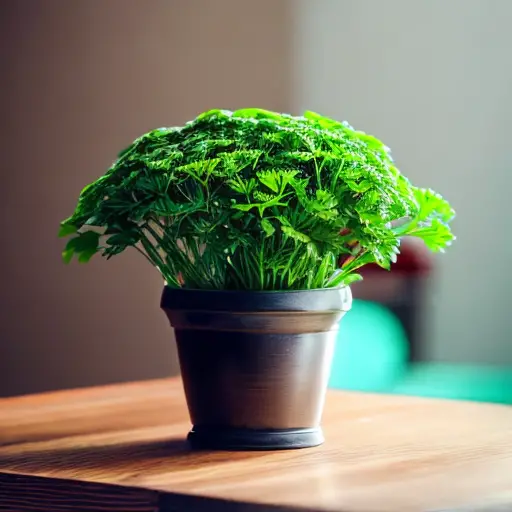Choosing the Right Pot and Soil: Essential Considerations for Indoor Parsley Plant Care
Indoor parsley plant care might seem like a walk in the park, but choosing the right pot and soil can make all the difference between a thriving herb and a sad, wilted excuse for parsley. First things first, let's talk pots. Now, you might be tempted to go for that fancy, decorative pot that matches your living room decor, but hold your horses! Parsley prefers a pot with good drainage, so opt for one with drainage holes to prevent your herb from drowning in soggy soil. As for the soil, parsley isn't too picky, but it does appreciate well-draining soil that's rich in organic matter. Think of it as the herb equivalent of a spa day – parsley likes to be pampered with loose, loamy soil that allows its roots to breathe and stretch. So, resist the urge to use that leftover potting soil from your failed tomato experiment and give your parsley the luxury treatment it deserves. Trust me, your taste buds will thank you later!
Providing Optimal Light and Temperature: Creating the Ideal Environment for Indoor Parsley
An interesting fact about taking care of parsley plants indoors is that they can actually help improve indoor air quality. Parsley plants are known to release high amounts of oxygen and absorb harmful toxins such as formaldehyde, making them natural air purifiers. So, not only do they add beauty and flavor to your indoor space, but they also contribute to a healthier living environment.
Creating the ideal environment for your indoor parsley plant involves more than just finding the perfect pot and soil. Lighting and temperature play a crucial role in parsley's growth and flavor development. Parsley loves basking in bright, indirect sunlight, so find a sunny spot near a window where it can soak up those rays without getting scorched. If natural light is limited, you can always supplement with artificial grow lights. Now, let's talk temperature. Parsley is a bit of a Goldilocks when it comes to temperature – not too hot, not too cold, but just right. Aim for a temperature range between 60 to 70 degrees Fahrenheit during the day and slightly cooler at night. So, if you want your parsley to be the envy of all the other herbs, give it the perfect lighting and temperature conditions. It's like creating a little paradise for your parsley, where it can thrive and bring a burst of fresh flavor to your culinary creations.
Watering and Fertilizing: Nurturing Your Indoor Parsley Plant for Healthy Growth

Nurturing your indoor parsley plant for healthy growth goes beyond just providing it with the right pot, soil, light, and temperature. Proper watering and fertilizing are essential to keep your parsley happy and thriving. When it comes to watering, parsley prefers to be kept evenly moist but not waterlogged. Overwatering can lead to root rot, while underwatering can cause the leaves to wilt and dry out. So, find that sweet spot by checking the moisture level of the soil regularly. Stick your finger about an inch deep into the soil, and if it feels dry, it's time to water. Give your parsley a good soak, allowing the excess water to drain out of the pot. Remember, parsley likes its drinks, but it doesn't want to drown!
In addition to proper watering, fertilizing your indoor parsley plant will provide it with the nutrients it needs to grow lush and flavorful. Start by choosing a balanced, water-soluble fertilizer with equal amounts of nitrogen, phosphorus, and potassium. During the growing season, which is typically spring and summer, feed your parsley plant every two to three weeks. Be sure to follow the instructions on the fertilizer package, as overfertilizing can lead to salt buildup and damage the roots. And remember, moderation is key – parsley doesn't need excessive amounts of fertilizer to thrive, just a little boost to keep it happy and healthy.
When it comes to nurturing your indoor parsley plant, proper watering and fertilizing are like the dynamic duo of care. They work hand in hand to provide your parsley with the perfect balance of moisture and nutrients. So, take the time to give your parsley the attention it deserves, and you'll be rewarded with a vibrant, flavorful herb that will elevate your culinary creations to new heights. Just imagine the satisfaction of sprinkling freshly harvested parsley on your dishes, knowing that you played a part in its healthy growth. It's like having a little green superstar right in your own home!
Pruning and Harvesting Techniques: Maintaining and Enjoying Your Indoor Parsley Bounty
A fun fact about taking care of a parsley plant indoors is that it loves to be serenaded! Studies have shown that playing soft music or talking to your parsley plant can actually promote its growth and overall health. So, don't be shy to sing your favorite tunes or have a little chat with your parsley buddy while tending to it – it might just make it thrive even more!
Maintaining and enjoying your indoor parsley bounty involves some pruning and harvesting techniques to keep your herb in top shape. As parsley grows, it's important to trim off any yellowing or damaged leaves to promote new growth and prevent disease. Simply snip off the unwanted leaves at the base, being careful not to damage the healthy ones. Additionally, regular harvesting encourages bushier growth and ensures a continuous supply of fresh parsley. When harvesting, start by cutting the outer leaves, leaving the inner ones to continue growing. This way, your parsley plant will keep producing new leaves for you to enjoy throughout the season. So, grab those pruning shears and get ready to savor the satisfaction of maintaining and harvesting your indoor parsley plant – a true green thumb's delight!

